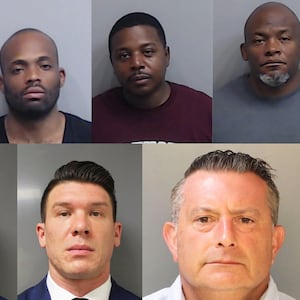The New York City Police Department’s tactics during the massive George Floyd protests over the summer “heightened tensions” between cops and residents, and were ridden with “deficiencies” that led to excessive use of force, according to a scathing report from the city’s watchdog.
The highly anticipated report, released by New York City’s Department of Investigation on Friday, acknowledged that “public trust is at a low ebb” in the city—in part because the NYPD didn’t have a “clearly defined strategy” on how to handle the protests. Millions of people took to the streets across the country after a white police officer held his knee on Floyd’s neck for nearly nine minutes in Minneapolis in May.
“NYPD use of force and crowd control tactics often failed to discriminate between lawful, peaceful protesters and unlawful actors, and contributed to the perception that officers were exercising force in some cases beyond what was necessary under the circumstances,” the report concluded.
After several weeks of peaceful protests that drew so many participants that Gov. Andrew Cuomo instituted a curfew to curtail the spread of COVID-19, demonstrations took a violent turn in June. Dozens of instigators looted stores and set police cars and trash cans on fire. But, in a terrifying show of force, hundreds of NYPD officers lined the streets for weeks, clashing with residents, arresting protesters en masse, kettling bystanders, and, in several publicized instances, exercising brutality on those who were protesting against police brutality.
The 111-page report particularly slammed the department’s lack of planning on how to handle the surge in protests. It “contributed to problems that then escalated tensions” as the protests only grew larger in size. The report notes that if the NYPD had coordinated with its own Community Affairs Bureau, which could have reached out with protest leaders, the violence would not have been nearly as intense.
“Our investigation revealed that NYPD’s primary strategy in at least the early days of the Floyd protests appears to have involved defaulting to an application of ‘disorder control’ tactics and methods, without adjustment to reflect the NYPD’s responsibility for facilitating lawful First Amendment expression,” the report says. “These deployment strategies, tactics, and shows of force exacerbated confrontations between police and protesters, rather than de-escalating tensions.”
The report adds that police tactics such as mass arrests, using pepper spray, and hitting protesters with batons failed to strike an “appropriate balance between valid public safety or officer safety interests and the rights of protesters to assemble and express their views.”
Investigators, however, didn’t address individual allegations of misconduct—like the officer who called a woman a bitch before shoving her to the pavement, the officer who drove his car into a group of protesters, or the officers who bashed cyclists with batons—and suggested that the majority of officers’ actions were “appropriate.”
“Some police officers engaged in actions that were at a minimum unprofessional and at worst unjustified excessive force or abuse of authority,” the report said. But, it added, the problems went beyond “poor judgment or misconduct" by individuals to departmental failures that escalated tensions and contributed “to both the perception and the reality” that excessive force was being used to suppress First Amendment rights.
Dounya Zayer, the 20-year-old protester who was shoved to the pavement, had only made the mistake of asking NYPD officer Vincent D’Andraia why he was forcefully ordering her off the street. Instead, he pushed her violently before saying, “Stupid fucking bitch.” Zayer was among dozens of New Yorkers who testified to the New York Attorney General about being beaten, arrested, and attacked by police officers during demonstrations. (D’Andraia is now facing charges.)
The NYPD, for their part, acknowledged in the report that the size and scope of the protests “surprised them” and “attributed any weakness in the policing strategy to the initial deployment of insufficient officers.”
The DOI report also includes proposals on how to improve the NYPD, including reform of police oversight and the creation of a protest response unit. The 20 recommendations also include a proposal for the NYPD to better consider the optics of their response, including more education and training about de-escalation, and re-thinking the use of units with riot gear during peaceful protests.
“In sum, the scope and nature of the Floyd protests posed several challenges to NYPD’s ability to respond, raised questions about the legitimacy of that response, and revealed some shortcomings in the NYPD’s approach and preparedness for policing First Amendment-protected protest activity,” the report concludes. “DOI’s investigation identified several deficiencies in NYPD’s policing of the Floyd protests, including its planning, strategy, tactics and enforcement, intelligence use, training, use of community affairs, and public communication. NYPD should pursue reform in these areas.”
Police Commissioner Dermot Shea released a statement acknowledging the recommendations on how to reform the department’s protest response but notably did not mention anything about oversight reform.
“In general terms, the report captured the difficult period that took place in May/June of 2020 and presents 20 logical and thoughtful recommendations that I intend to incorporate into our future policy and training,” he said.
Mayor Bill de Blasio, who directed the DOI in May to investigate the NYPD’s handling of the protests, released a six-minute video message supporting the report’s findings and recommendations.
“It’s a season of reflection right now, that’s what the holidays are,” de Blasio said. “I read this report, and I agree with it. I agree with its analysis and I agree with its recommendations because it makes very clear we got to do something different, and we got to do something better.”
Not all public leaders accepted the report’s findings. Pat Lynch, the combative president of the Police Benevolent Association, said that the report confirmed what police had been faced with from the first night of rioting: “Our city leaders sent us out with no plan, no strategy, and no support to deal with unrest that was fundamentally different from any of the thousands of demonstrations that police officers successfully protect every single year.”
“Nearly 400 police officers were injured—struck with bricks, bottles, fire extinguishers, and folding chairs—because of the mixed messages emanating from City Hall and Albany,” Lynch said in a statement. “No amount of new training or strategizing will help while politicians continue to undermine police officers and embolden those who create chaos on our streets.”









